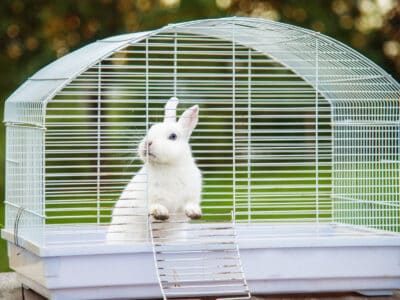Mouse Poop vs Bat Poop: What Are 8 Key Differences?
@media (min-width: 481px) {
.mobile-top-content {
display: none;
}
}
#mobileTopContentCTACarouselControls { overflow: hidden; text-overflow: ellipsis; white-space: nowrap; }
.mobile-top-content .more { color: #fff; }
.mobile-top-content a { color: #fff; text-decoration: underline; }
.mobile-top-content a:hover { color: #fff; text-decoration: underline; }
@media (max-width: 480px) {
.mobile-top-content {
background-color: #06a10b;
color: #fff;
text-align: center;
/*height: 60px;
padding-top:5px;*/
font-size:80%;
/* display: block; */
margin: 0px -30px;
}
}
The droppings of bats are remarkably like that of mice, which is why they’re often mistaken. Until you get a closer look, they both appear black and roughly the same size and shape. Knowing what details to look for while dealing with a rodent infestation is critical, especially if you’ve never dealt with one before. There are certain differences between mouse and bat poop that can help you ascertain which rodent has left their droppings.
Mouse Poop vs Bat Poop: A Comparison
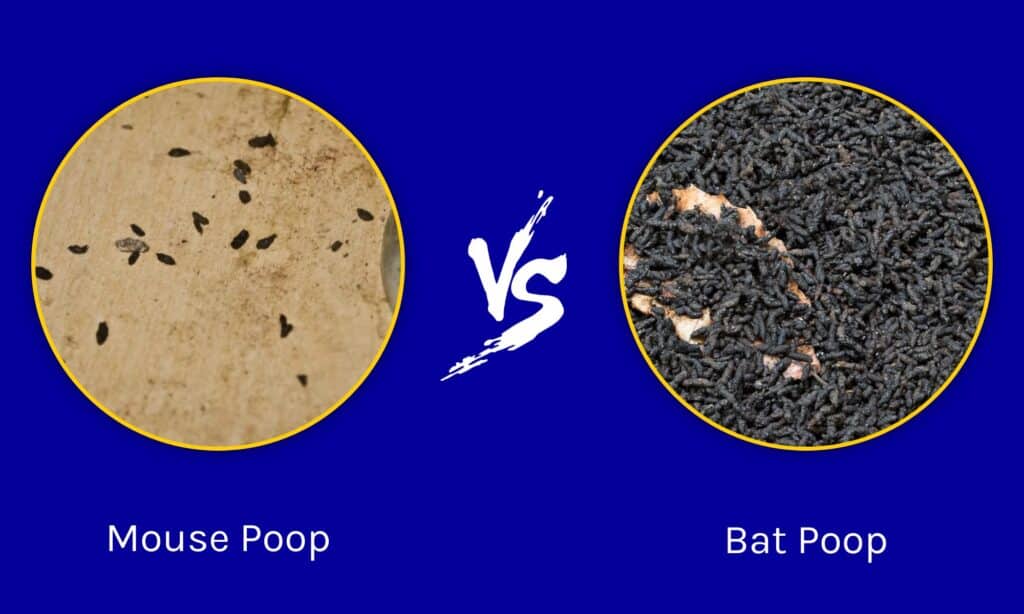
A-Z-Animals.com
| MOUSE DROPPINGS | BAT DROPPINGS | |
|---|---|---|
| Size | Length 1/8 to ¼ inch | Length ¼ to ½ inch |
| Color | Black; Old Droppings Are Dull, But New Droppings Shine | Blackish in color, even old droppings glisten |
| Shape | One or both ends pointed | Ends blunt, not pointed |
| Texture | Fresh droppings are soft with a putty-like texture | Fresh droppings break and crumble easily |
| Components | Often contain rodent hairs | Shiny insect parts easily seen |
| Location | All Over; Scattered | In Attics/Small Spaces; Found In Piles |
| Danger Level | Hantavirus | Fungal Diseases |
The Key Differences Between Mouse Poop and Bat Poop
The key differences between mouse poop and bat poop are appearance and characteristics.
Let’s explore these in detail!
Appearance
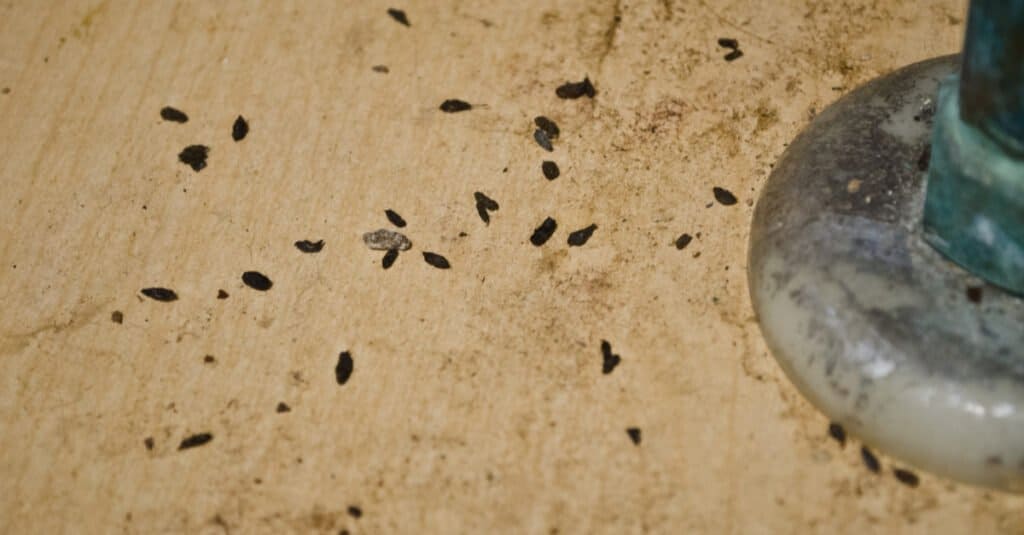
Pegasene/Shutterstock.com
Mouse Poop vs Bat Poop: Size
A mouse’s droppings are around a quarter of an inch. The size and shape of bat droppings are comparable to those of a mouse’s (approximately 1/3 inch).
Mouse Poop vs Bat Poop: Color
It’s common to see shiny black feces in the excrement of bats. Black or nearly black in color, fresh mouse droppings appear wet and slick when they’ve just fallen. Stale-looking mouse droppings that have been sitting around for a lengthy period are gray in color.
Mouse Poop vs Bat Poop: Shape
House mice excrete cone-shaped droppings with a pointed tip. Bat droppings are elongated and have blunt ends, unlike mouse droppings.
Characteristics
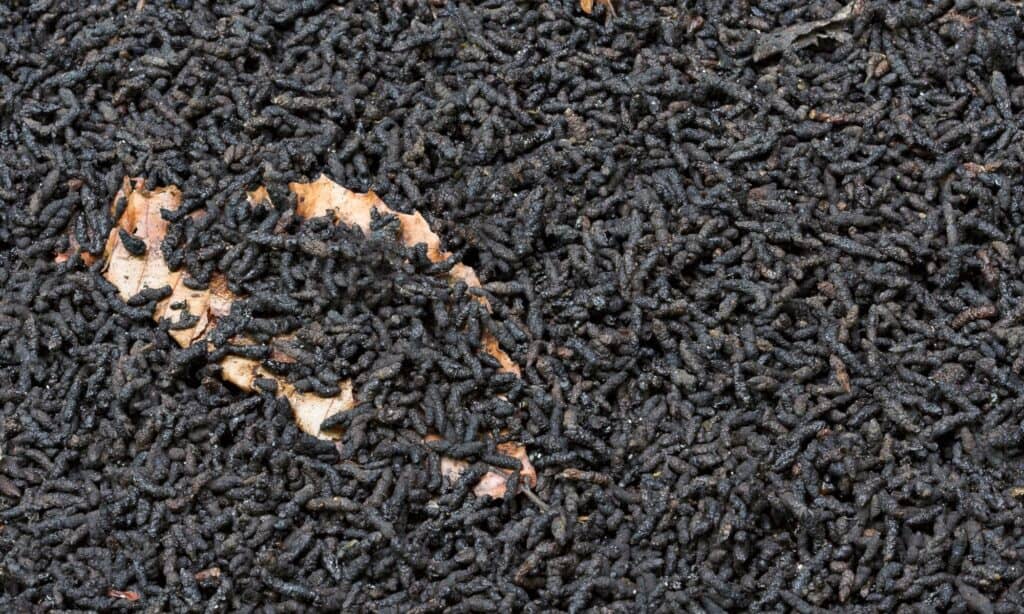
iStock.com/sbonk
Mouse Poop vs Bat Poop: Texture
The age of the mouse droppings might tell you if the infestation is still going on. Fresh mouse feces are sticky and slimy. Bat guano is glossy but crumbles when it’s broken down.
Mouse Poop vs Bat Poop: Components
The discrepancy in droppings is due to the animals’ diet. Bats eat insects and leave shiny insect bits in their droppings. Since the droppings have undigested pieces of bugs, they crumble readily. Insect pieces may be found in mouse droppings. However, insects are not their preferred food. Mouse excrement mostly contains mouse hairs from grooming.
Mouse Poop vs Bat Poop: Location
Bat droppings are usually found in piles, whereas mouse poop is usually scattered. A single mouse can leave up to 70 droppings every day scattered about! Most mouse droppings are found near (but not in) mouse nests and feeding areas.
Large numbers of bats roosting in an attic for a lengthy period are common causes of bat dropping buildup. Many older homes lack attic floor insulation. An abundance of bat guano and urine in the attic can stain the ceilings of your home.
Mouse Poop vs Bat Poop: Danger Level
Fungal diseases are spread through bat droppings. The main worry is histoplasmosis. Histoplasmosis is caused by inhaling fungus spores found in bird or bat droppings. Human exposure occurs when disrupted droppings become airborne during cleanup. Most people do not get sick from inhaling spores. However, a lung infection with flu-like symptoms in some people could also progress to a deadly chronic condition that resembles tuberculosis. Histoplasmosis capsulatum spores typically form in three-year-old droppings.
Mouse feces can transmit bacteria, taint food, and cause allergic reactions in humans. Dry feces pose a risk to those who inhale their particles. This can happen while cleaning. Mouse droppings can also spread illnesses and viruses, such as Hantavirus. Symptoms begin 1-8 weeks after contact exposure. Early symptoms include weariness, fever, and muscle aches. Nausea, vomiting, diarrhea, and stomach pain may also occur. These symptoms affect almost half of HPS patients. The late symptoms of HPS emerge 4-10 days after the first illness. Coughing and shortness of breath are symptoms of lungs filling with liquid. HPS is deadly, with a 38% fatality rate. In case of exposure to mouse droppings and any of the symptoms listed above, seek medical attention immediately.
Conclusion
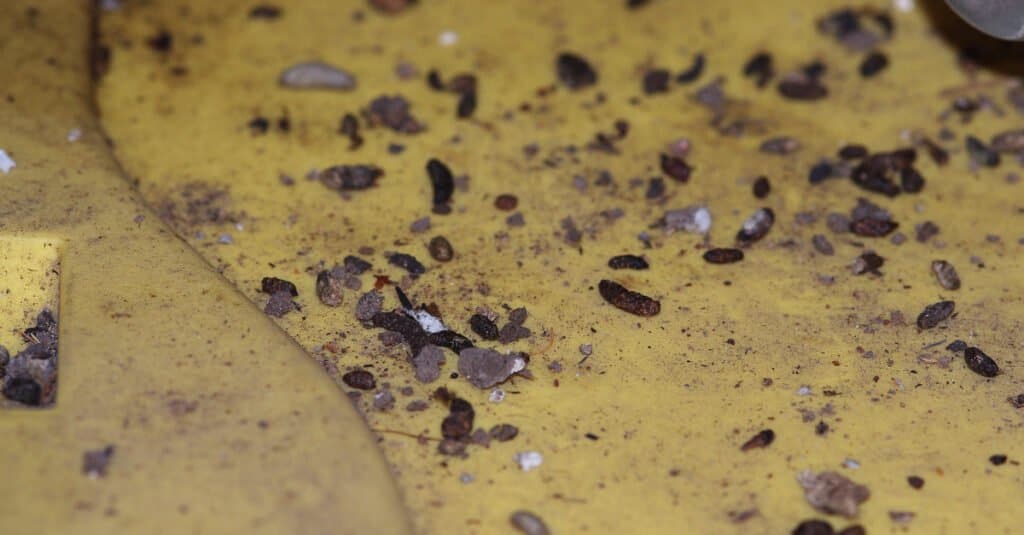
Photo – TMD/Shutterstock.com
Even though bats and mice are good for the environment, most people don’t like having these little critters in their houses. They can carry and spread infections, and their droppings and urine can smell. If you suspect that you have an infestation, it is recommended to contact your local pest control service to thoroughly evaluate the situation and remove the rodents in a humane and safe manner. Don’t touch or clean any droppings without wearing a mask and gloves!
More from A-Z Animals
.more-snake-card-image { max-height:140px !important; }
@media (min-width: 481px) {
.mobile-top-content {
display: none;
}
}
#mobileTopContentCTACarouselControls { overflow: hidden; text-overflow: ellipsis; white-space: nowrap; }
.mobile-top-content .more { color: #fff; }
.mobile-top-content a { color: #fff; text-decoration: underline; }
.mobile-top-content a:hover { color: #fff; text-decoration: underline; }
@media (max-width: 480px) {
.mobile-top-content {
background-color: #06a10b;
color: #fff;
text-align: center;
/*height: 60px;
padding-top:5px;*/
font-size:80%;
/* display: block; */
margin: 0px -30px;
}
}
The droppings of bats are remarkably like that of mice, which is why they’re often mistaken. Until you get a closer look, they both appear black and roughly the same size and shape. Knowing what details to look for while dealing with a rodent infestation is critical, especially if you’ve never dealt with one before. There are certain differences between mouse and bat poop that can help you ascertain which rodent has left their droppings.
Mouse Poop vs Bat Poop: A Comparison

A-Z-Animals.com
| MOUSE DROPPINGS | BAT DROPPINGS | |
|---|---|---|
| Size | Length 1/8 to ¼ inch | Length ¼ to ½ inch |
| Color | Black; Old Droppings Are Dull, But New Droppings Shine | Blackish in color, even old droppings glisten |
| Shape | One or both ends pointed | Ends blunt, not pointed |
| Texture | Fresh droppings are soft with a putty-like texture | Fresh droppings break and crumble easily |
| Components | Often contain rodent hairs | Shiny insect parts easily seen |
| Location | All Over; Scattered | In Attics/Small Spaces; Found In Piles |
| Danger Level | Hantavirus | Fungal Diseases |
The Key Differences Between Mouse Poop and Bat Poop
The key differences between mouse poop and bat poop are appearance and characteristics.
Let’s explore these in detail!
Appearance

Pegasene/Shutterstock.com
Mouse Poop vs Bat Poop: Size
A mouse’s droppings are around a quarter of an inch. The size and shape of bat droppings are comparable to those of a mouse’s (approximately 1/3 inch).
Mouse Poop vs Bat Poop: Color
It’s common to see shiny black feces in the excrement of bats. Black or nearly black in color, fresh mouse droppings appear wet and slick when they’ve just fallen. Stale-looking mouse droppings that have been sitting around for a lengthy period are gray in color.
Mouse Poop vs Bat Poop: Shape
House mice excrete cone-shaped droppings with a pointed tip. Bat droppings are elongated and have blunt ends, unlike mouse droppings.
Characteristics

iStock.com/sbonk
Mouse Poop vs Bat Poop: Texture
The age of the mouse droppings might tell you if the infestation is still going on. Fresh mouse feces are sticky and slimy. Bat guano is glossy but crumbles when it’s broken down.
Mouse Poop vs Bat Poop: Components
The discrepancy in droppings is due to the animals’ diet. Bats eat insects and leave shiny insect bits in their droppings. Since the droppings have undigested pieces of bugs, they crumble readily. Insect pieces may be found in mouse droppings. However, insects are not their preferred food. Mouse excrement mostly contains mouse hairs from grooming.
Mouse Poop vs Bat Poop: Location
Bat droppings are usually found in piles, whereas mouse poop is usually scattered. A single mouse can leave up to 70 droppings every day scattered about! Most mouse droppings are found near (but not in) mouse nests and feeding areas.
Large numbers of bats roosting in an attic for a lengthy period are common causes of bat dropping buildup. Many older homes lack attic floor insulation. An abundance of bat guano and urine in the attic can stain the ceilings of your home.
Mouse Poop vs Bat Poop: Danger Level
Fungal diseases are spread through bat droppings. The main worry is histoplasmosis. Histoplasmosis is caused by inhaling fungus spores found in bird or bat droppings. Human exposure occurs when disrupted droppings become airborne during cleanup. Most people do not get sick from inhaling spores. However, a lung infection with flu-like symptoms in some people could also progress to a deadly chronic condition that resembles tuberculosis. Histoplasmosis capsulatum spores typically form in three-year-old droppings.
Mouse feces can transmit bacteria, taint food, and cause allergic reactions in humans. Dry feces pose a risk to those who inhale their particles. This can happen while cleaning. Mouse droppings can also spread illnesses and viruses, such as Hantavirus. Symptoms begin 1-8 weeks after contact exposure. Early symptoms include weariness, fever, and muscle aches. Nausea, vomiting, diarrhea, and stomach pain may also occur. These symptoms affect almost half of HPS patients. The late symptoms of HPS emerge 4-10 days after the first illness. Coughing and shortness of breath are symptoms of lungs filling with liquid. HPS is deadly, with a 38% fatality rate. In case of exposure to mouse droppings and any of the symptoms listed above, seek medical attention immediately.
Conclusion

Photo – TMD/Shutterstock.com
Even though bats and mice are good for the environment, most people don’t like having these little critters in their houses. They can carry and spread infections, and their droppings and urine can smell. If you suspect that you have an infestation, it is recommended to contact your local pest control service to thoroughly evaluate the situation and remove the rodents in a humane and safe manner. Don’t touch or clean any droppings without wearing a mask and gloves!



